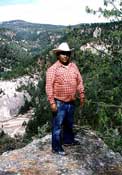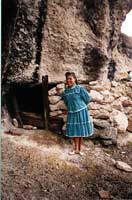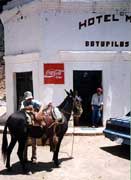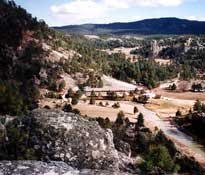
|
Mexico's Copper Canyon: Another View
|

|
Posted Friday, January 1, 1999
To better grasp the Copper Canyon country's immense size and impact, imagine if the entire state of Colorado was surrounded by several Grand Canyons -- and that the state could only be reached by narrow mule trails and a few poorly maintained gravel roads. Remove virtually all of the cities and replace them with forests of pine, oak and aspen. Replace towns with mesas and cover the malls and urban sprawl with meadows and empty grasslands. Add stunning blue skies and a very sparse population of Tarahumara Indians, Mexican ranchers, loggers and scattered prospectors. Do you understand why I consider the Sierra Madre to be an undiscovered paradise?
In Mexico's Copper Canyon, "local knowledge" is the name of the game. Although this region of mountains, mesas and canyonlands holds countless trails just begging to be explored, outsiders soon learn that virtually none are marked or accurately mapped. Known mainly by prospectors, Tarahumara goatherds, smugglers and a few widely scattered ranchers, this vast territory of forested plateaus and precipitous canyons is both a paradise and a paradox for hikers: without a reliable guide, getting lost in the Sierra Madre's topographic maze isn't just easy, it's almost guaranteed.

With reliable information so scarce, it's no surprise that most hikers venture no farther than a few trails near Creel and Divisadero. A two mile ramble to a highland waterfall near Cusarare, the heavily trodden Recoata hotsprings trail, or a steep rocky descent below the rim at Divisadero are the most common choices. The commercial outfitters and guides I've met in the canyons also tend to favor better -known routes. With few exceptions, "trans-canyon" hiking groups take the traditional camino real between the old mining villages of Batopilas and Urique. It's all a great adventure, of course, but for most visitors, the several thousand square mile expanse of unknown territory that lies just beyond these few trails might as well be the dark side of the moon.
As a travel writer and do-it-yourself explorer, I'd nibbled at the edges of this exciting region for many years. It wasn't until I took a job as resident guide and expert "talking head" with the Copper Canyon Lodges, however, that the canyonlands and Sierra Tarahumara really opened up to me. For the better part of two years, I was able to explore both the highlands surrounding the Sierra Lodge at Cusarare, and, from the Riverside Lodge at Batopilas, the awesome gorge and tributaries of this more-than-mile-deep canyon. (I now continue my explorations by leading small groups on burro-assisted treks into the barrancas.)

In my vaguely defined role as guide and in-house Mexico expert, I often invited one of the Lodge's staff on my outings or hired local Tarahumara Indians and Mexicans to assist me. My "guide" title might impress our guests, but in terms of actual canyon experience, I was just another raw greenhorn. Whenever my position threatened to go to my head, a quick sobering look at a topo map was enough to bring me quickly back to earth. The true Copper Canyon experts were the uneducated farmers, ranchers, prospectors and maids who made up our staff. I was simply their student, eagerly gathering crumbs from their lifelong experience in this amazing country.
As so many travelers have learned, expressions of polite curiosity and genuine interest in others can transform even the most guarded, taciturn Mexicans into willing tutors. On one of my first hikes, Rosa, a young chambermaid at the Sierra Lodge, explained the importance of greeting her people in their own language, Raramuri, rather than in Spanish. On another outing, I gained further insight into the shy, reclusive nature of the Tarahumara when the Lodge's handyman described the tremendous fear his people had of outsiders during the 1910 Revolution. Resting in the sun in front of his grandfather's long-abandoned cliff dwelling, Manuelito told me, "They didn't understand the war," he said. "So they hid in these caves. Their fear was so great that some people died of hunger rather than come out."
Later, on May afternoons in the bottom of the Batopilas canyon, trail temperatures sizzled at 115 degrees and higher. I learned -- the hard way -- to pack a spare hat and a full gallon of drinking water. In hindsight, an old lady carrying a bucket of ripe "tuna" also taught me to never again decline an invitation from an old lady carrying a bucket to eat the delicious, re-energizing fruit of the cardon cactus.

In spite of the repetitious nature of my work at the Lodges, hiking was rarely boring. In fact, I came to expect an adventure on every precipitous trail -- or at the very least, a clue that might lead me to a long-lost Spanish mine. For a change of pace, I might wash grains of pure silver from the river bed near the Lodge with a wooden pan, drop in on a schizophrenic Mexican moonshiner, or visit an amiable family of opium and marijuana farmers. On a day that began like many others, a 72 year-old Yaqui prospector introduced me to one of the last Tarahumara bow hunters, then led me to an ancient ruined village hidden on a fortress-like mesa. Experiences such as these soon wore the soles off a very tough pair of leather hiking boots.
The longer I worked at the Lodges, the more excited I became. To begin with, the territory that travel writers offhandedly describe as the "Copper Canyon" is actually an entire country of canyons, covering more than ten thousand square miles. This includes a huge expanse of the Sierra Madre, the "Mother Range" of North America, known locally as the Sierra Tarahumara.

Although little has been published about hiking in the Copper Canyon, a great deal is known about the region. Again, however, this is local knowledge, held almost exclusively by those who live there. Fortunately, pestering people for information is one of my favorite pastimes. I was aided by the fact that tourism is still a novelty in most of the Sierra Madre. The typical Mexican "serrano" (mountain person) might be a tad shy of bearded gringos at first, but these people still maintain old-fashion traditions of hospitality and spirited storytelling. They dearly love to spin tales and i-ncredible yarns, especially to fresh, uncritical ears. Once my reputation as a good listener was established, it seemed that every bowlegged, sunburnt character in the Sierra Madre was willing to recount some amazing tale or offer me a tour (and sometimes even a share) of a fabulously rich silver mine.
I might have been skeptical about digging for treasure, but as a writer, I'd clearly struck the mother lode. Better yet, as a guide-in-training, the trail lore and survival tips my informants offered were priceless.

In learning my way around the principal trails and finest viewpoints, I eventually acquired a much broader and more general sense of the lay-of-the-land. As my confidence grew, however, so did the desire to strike out on my own. As much as I enjoyed hiking with others, one of the greatest attractions these canyons hold for me is their deep, penetrating solitude. Determined to enjoy this on my own, I stuffed a large daypack with food, water and survival gear, and began systematically probing deeper and deeper into unknown country.
Cusarare and the Sierra Madre Highlands are continued in Part Two of Another View

| Home
| Carl's Notebook
| Best of Mexico
| FAQ
| Books & Maps
| Travel Center
| Copper Canyon |
| Driving
| Health
| Retire
| RV
| Spanish
| Working
| The People's Guide to Mexico
| Letters
| Links |
Copyright 1972-2004, Carl Franz and Lorena Havens. All rights reserved. E-mail us.![]() i
i





